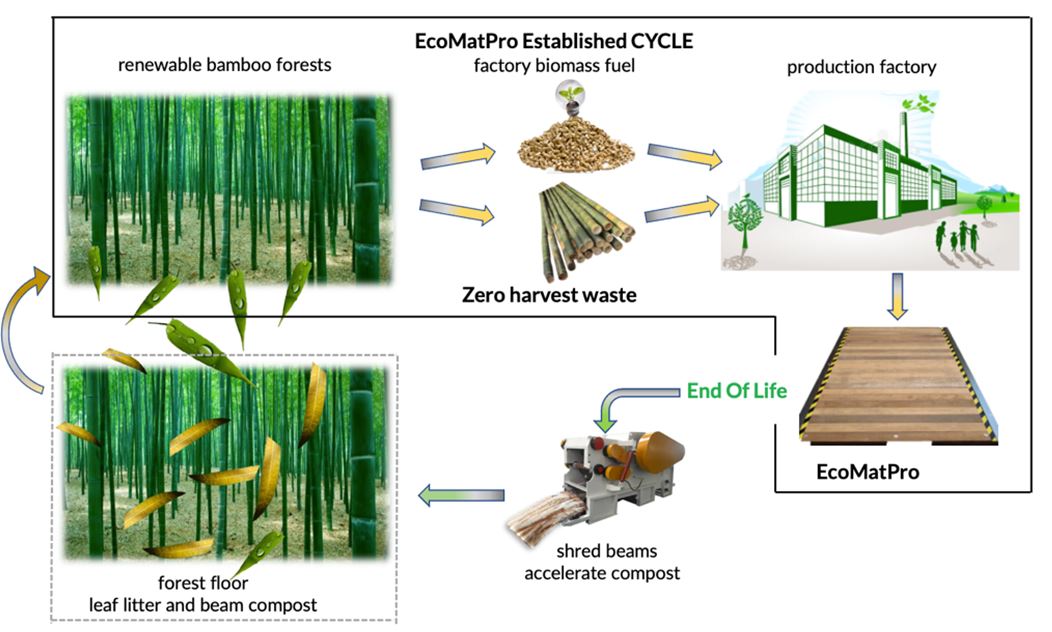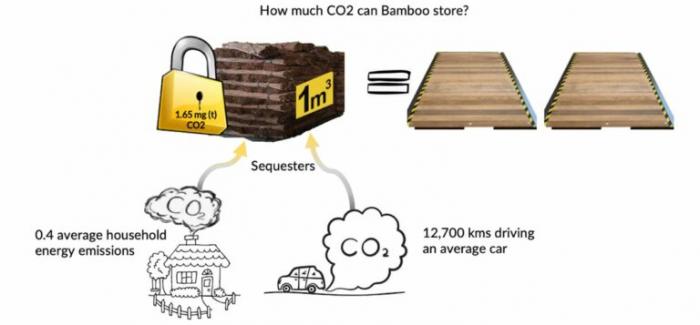
Carbon sequester capability LCA of EcoMatPro ultra-dense bamboo matting system
Introduction
EcoMatPro commissioned an assessment to determine the carbon footprint of its products to support environmental reporting across our range of products. Various Official Life Cycle Assessment (LCA) studies (ISO 14040/44) confirmed that most solid Bamboo products are CO2 neutral or better over their full life cycle from start to finish.
Additionally, the latest LCA results presented to the International Network for Bamboo and Rattan (INBAR) indicate a negative footprint is achievable and sustainable, with appropriate end of life disposal techniques.
EcoMatPro LCA Summary
EcoMatPro follow a strict eco-friendly manufacturing process from harvest to final product disposal. Renewable A1 quality high altitude Bamboo crops are managed, farmed and harvested from Forestry Stewardship Council (FSC) certified areas. Our primary cropping area of 144,000 ha is divided into a rotational harvesting sequence, administered by local cooperatives. Harvesting commences on a 4 – 5 year growth cycle, when the culms are at peak height, maturity and strength.
During the manufacturing process of EcoMatPro high density beams, traditional splitting and drying methods are employed. A proprietary “flex weave” process delivers superior density (m3) and tensile strength. Eco-friendly resin bonds the bamboo fibers to approved (E0-E1) standards.
Bio-based materials act as CO2 locks
Due to the extensive Flex Weave™ process delivering ultra dense beams, the EcoMatPro product captures and stores a significant amount of CO2, as much as 1,696 ton CO2 per m³ of bamboo, calculated on the dense EcoMatPro HDSW™ range. A positive side-effect of harvesting the bamboo culm, the mother plant produces new stems, while at the same time capturing more CO2, providing our continual supply of new raw material. In fact, because of the rapid growth cycle, the carbon stored in the durable products pool is higher for bamboo than for other bio-based materials, including most wood species
How much CO2 is locked in bamboo?
Calculating the CO2 locked in bio-based materials, including bamboo, can be calculated following the European norms EN 16785-2 (for establishing bio-based content) and EN 16449 (originally designed for wood, may also be used for bio-based materials with similar biogenic carbon content). Around half of the mass of oven-dry bio-based material (wood / bamboo) consists of carbon. The ratio of the molecular weight of CO2 (44g/mol) to C (12g/mol) is 3.67. The CO2 locked in the durable products can be calculated rather simply based on the density of the bamboo species, taking into account the moisture and glue content. The greater the weight per m³, the more CO2 is locked. For example, EcoMatPro HDSW, with a density of 1200 kg/m³, consists of 95% bamboo (1140 kg/m³) with a moisture content of 6%, which is 1071 kg / m³ dry biomass at 0% moisture content. Half of this mass, 536 kg/m³, is biogenic carbon content. Multiplied by the ratio of molecular weight of CO2 to C (3.67) results in 1967 kg CO2 /m³. Significantly higher than most wood species (e.g. pine at 450 kg/m³ locks around 737 kg CO2.

Key drivers to achieve net negative carbon footprint
EcoMatPro harvests only renewable FSC managed forests.
Our Bio-mass fuelled production facility completes the eco-friendly matting end product process.
We are undertaking strategic planning for EOL disposal, as shredded compost material to complete the C-2-C cycle.

The future: 100% Cradle 2 Cradle compliant bamboo matting system.
It’s clear that industrial bamboo products, from sustainable sourced bamboo material, can complete the biocycle of the Cradle to Cradle (C2C) concept, focusing on renewable, eco-friendly products which eliminate waste throughout their entire life cycle. EcoMatPro embrace this cycle during each manufacturing phase, striving for a carbon negative footprint. Our core negative carbon footprint strategy is complete with the final key disposal element, upcycling the EcoMatPro product through natural compost disposal of the matting, delivers the complete organic cycle.
